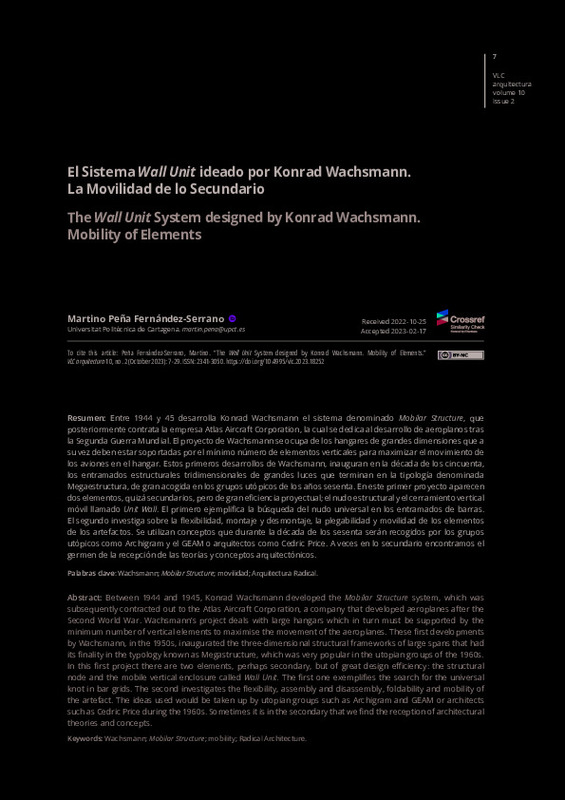JavaScript is disabled for your browser. Some features of this site may not work without it.
Buscar en RiuNet
Listar
Mi cuenta
Estadísticas
Ayuda RiuNet
Admin. UPV
The Wall Unit System designed by Konrad Wachsmann. Mobility of Elements
Mostrar el registro sencillo del ítem
Ficheros en el ítem
| dc.contributor.author | Peña Fernández-Serrano, Martino
|
es_ES |
| dc.date.accessioned | 2023-11-15T11:35:41Z | |
| dc.date.available | 2023-11-15T11:35:41Z | |
| dc.date.issued | 2023-10-31 | |
| dc.identifier.issn | 2341-3050 | |
| dc.identifier.uri | http://hdl.handle.net/10251/199784 | |
| dc.description.abstract | [EN] Between 1944 and 1945, Konrad Wachsmann developed the Mobilar Structure system, which was subsequently contracted out to the Atlas Aircraft Corporation, a company that developed aeroplanes after the Second World War. Wachsmann's project deals with large hangars which in turn must be supported by the minimum number of vertical elements to maximise the movement of the aeroplanes. These first developments by Wachsmann, in the 1950s, inaugurated the three-dimensional structural frameworks of large spans that ended up in the typology known as Megastructure, which was very popular in the utopian groups of the 1960s. In this first project there are two elements, perhaps secondary, but of great design efficiency: the structural node and the mobile vertical enclosure called Wall Unit. The first one exemplifies the search for the universal knot in bar grids. The second investigates the flexibility, assembly and disassembly, foldability and mobility of the artefact. The ideas used will would be taken up by utopian groups such as Archigram and GEAM or architects such as Cedric Price during the 1960s. Sometimes it is in the secondary that we find the germ of the reception of architectural theories and concepts. | es_ES |
| dc.description.abstract | [ES] Entre 1944 y 45 desarrolla Konrad Wachsmann el sistema denominado Mobilar Structure, que posteriormente contrata la empresa Atlas Aircraft Corporation, la cual se dedica al desarrollo de aeroplanos tras la Segunda Guerra Mundial. El proyecto de Wachsmann se ocupa de los hangares de grandes dimensiones que a su vez deben estar soportadas por el mínimo número de elementos verticales para maximizar el movimiento de los aviones en el hangar. Estos primeros desarrollos de Wachsmann inauguran en la década de los cincuenta los entramados estructurales tridimensionales de grandes luces que terminan en la tipología denominada Megaestructura, de gran acogida en los grupos utópicos de los años sesenta. En este primer proyecto aparecen dos elementos de gran eficiencia proyectual; el nudo estructural y el cerramiento vertical móvil llamado Unit Wall. El primero ejemplifica la búsqueda del nudo universal en los entramados de barras. El segundo investiga sobre la flexibilidad, montaje y desmontaje, la plegabilidad y movilidad de los artefactos. Se utilizan conceptos que durante la década de los sesenta serán recogidos por los grupos utópicos como Archigram y el GEAM o arquitectos como Cedric Price. A veces en lo secundario encontramos el germen de la recepción de las teorías y conceptos arquitectónicos. | es_ES |
| dc.language | Español | es_ES |
| dc.language | Inglés | es_ES |
| dc.publisher | Universitat Politècnica de València | es_ES |
| dc.relation.ispartof | VLC arquitectura. Research Journal | es_ES |
| dc.rights | Reconocimiento - No comercial (by-nc) | es_ES |
| dc.subject | Wachsmann | es_ES |
| dc.subject | Mobilar Structure | es_ES |
| dc.subject | Mobility | es_ES |
| dc.subject | Radical Architecture | es_ES |
| dc.subject | Movilidad | es_ES |
| dc.subject | Arquitectura Radical | es_ES |
| dc.title | The Wall Unit System designed by Konrad Wachsmann. Mobility of Elements | es_ES |
| dc.title.alternative | El sistema Wall Unit ideado por Konrad Wachsmann. La Movilidad de lo Secundario | es_ES |
| dc.type | Artículo | es_ES |
| dc.identifier.doi | 10.4995/vlc.2023.18252 | |
| dc.rights.accessRights | Abierto | es_ES |
| dc.description.bibliographicCitation | Peña Fernández-Serrano, M. (2023). The Wall Unit System designed by Konrad Wachsmann. Mobility of Elements. VLC arquitectura. Research Journal. 10(2):7-29. https://doi.org/10.4995/vlc.2023.18252 | es_ES |
| dc.description.accrualMethod | OJS | es_ES |
| dc.relation.publisherversion | https://doi.org/10.4995/vlc.2023.18252 | es_ES |
| dc.description.upvformatpinicio | 7 | es_ES |
| dc.description.upvformatpfin | 29 | es_ES |
| dc.type.version | info:eu-repo/semantics/publishedVersion | es_ES |
| dc.description.volume | 10 | es_ES |
| dc.description.issue | 2 | es_ES |
| dc.identifier.eissn | 2341-2747 | |
| dc.relation.pasarela | OJS\18252 | es_ES |
| dc.description.references | Archigram. Archigram. New York: Princeton Architectural Press, 1999. | es_ES |
| dc.description.references | Cook, Peter. Archigram. The Book. Zurich: Park Books, 2018. | es_ES |
| dc.description.references | Grüning, Michael. Der Wachmann-Report. Auskünfte eines Architekten. Berlin: Verlag der Nation., 1985. | es_ES |
| dc.description.references | Koolhaas, Rem and Hans Ulrich Obrist. Project Japan. Metabolism talks. Colonia: Taschen GmbH, 2011. | es_ES |
| dc.description.references | Peña Fernández Serrano, Martino. “El seminario de Wachsmann en Japón. Las influencias compartidas.” RITA 8, no. 8 (2017). | es_ES |
| dc.description.references | Price, Cedric. “Fun Palace, Camden, London.” Architectural Design, no. 37 (1965). | es_ES |
| dc.description.references | Wachsmann, Konrad, Charles Wohlstetter, and Albert Wohlstetter. Building Construction. USA: United States Patent Office. 1949. | es_ES |
| dc.description.references | Wachsmann, Konrad, CharlesWohlstetter, and Albert Wohlstetter. Building structure. USA: United States Patent Office. 1951. | es_ES |
| dc.description.references | Wachsmann, Konrad. “Space Frame Hangar.” Architectural Forum, (Septembe 1954).Wachsmann, Konrad. Wendepunkt im Bauen. Dresden: VEB Verlag der Kunst, 1989. | es_ES |
| dc.description.references | Wachsmann, Konrad. KWA 134. Atlas Aircraft. Berlin. Akademie der Künste. | es_ES |
| dc.description.references | Wachsmann, Konrad. KWA 300. A new Method of Construction. Berlin. Akademie der Künste. | es_ES |
| dc.description.references | Wachsmann, Konrad. KWA 798. Yona Friedman and Konrad Wachsmann. Berlin. Akademie der Künste. | es_ES |
| dc.description.references | Wachsmann, Konrad. KWA 2518. Mobilar structure. Berlin. Akademie der Künste. | es_ES |
| dc.description.references | Wikipedia. Albert Wohlstetter. 19 de April 2022. https://en.wikipedia.org/wiki/Albert_Wohlstetter | es_ES |








